Sir John Monash, Personal Files Book 13, 1 July - 16 August 1916, Part 11
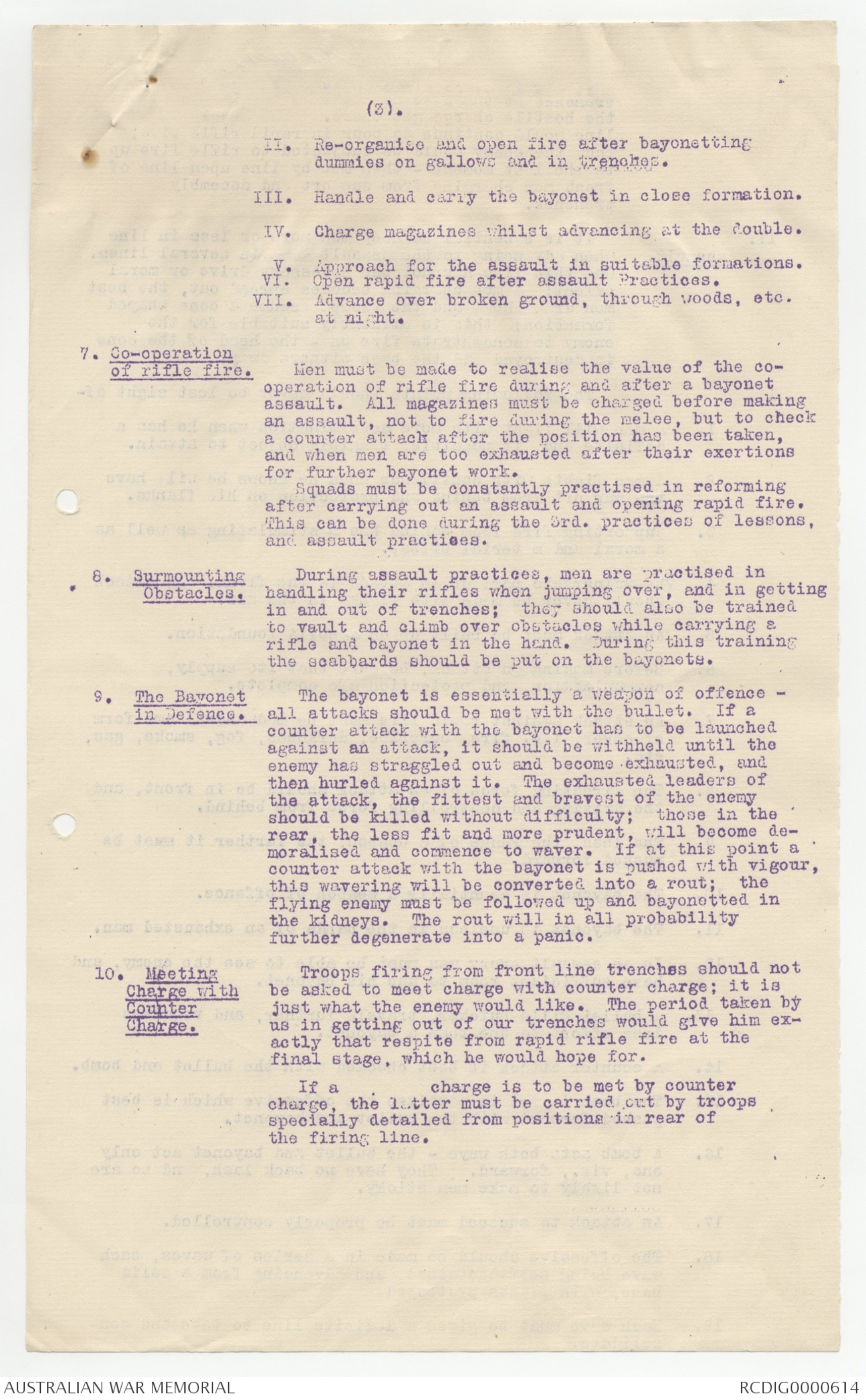
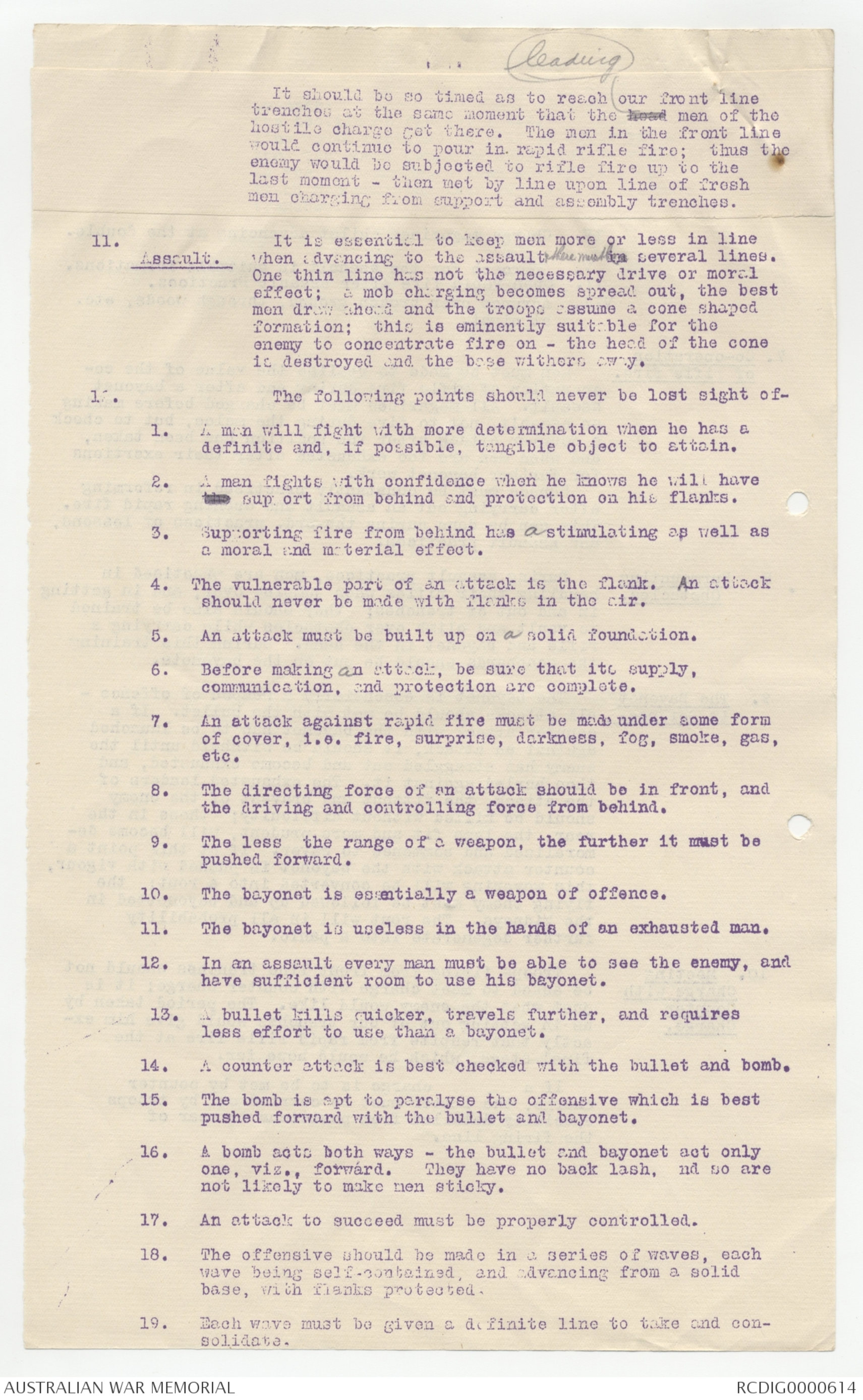
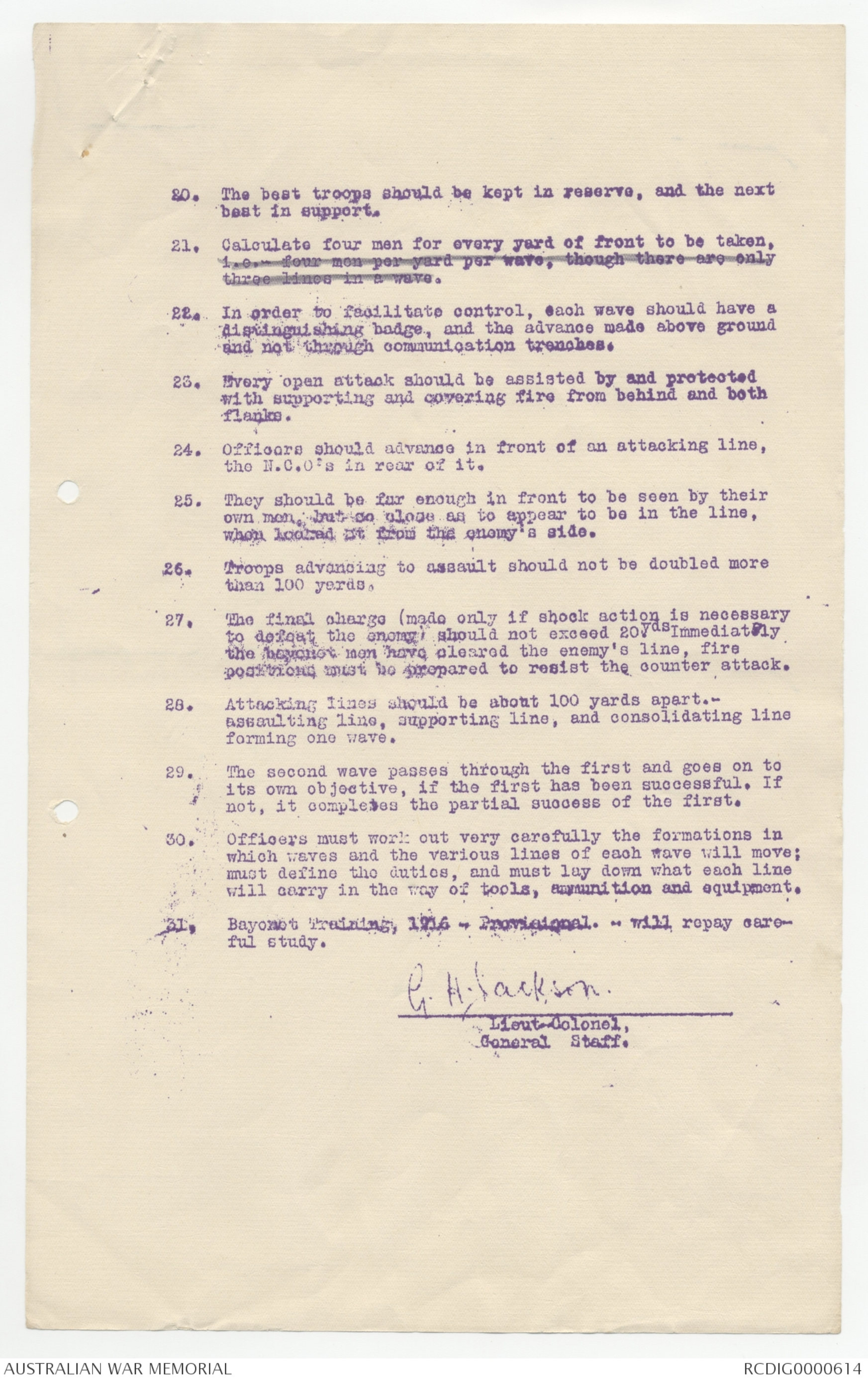
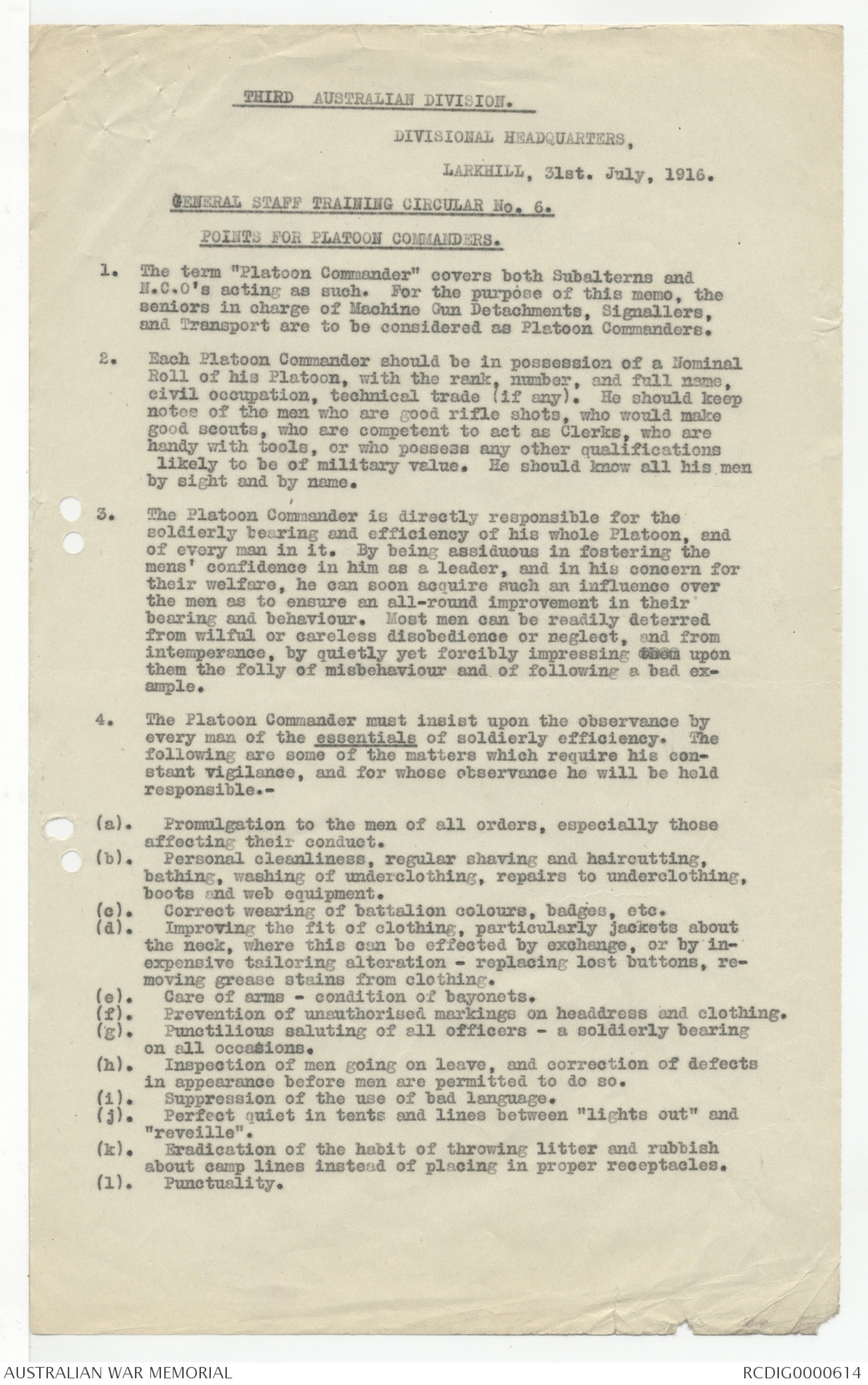
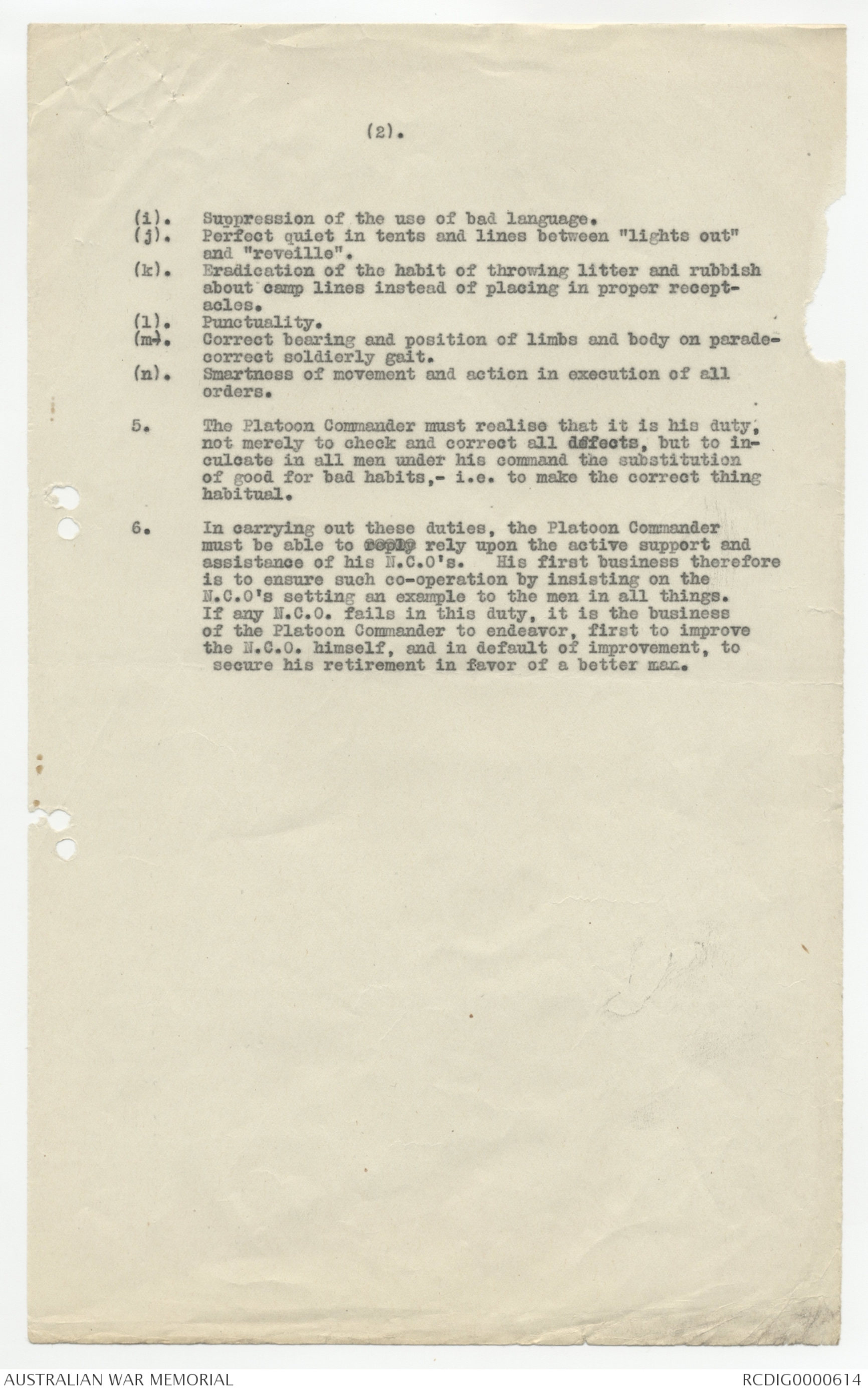
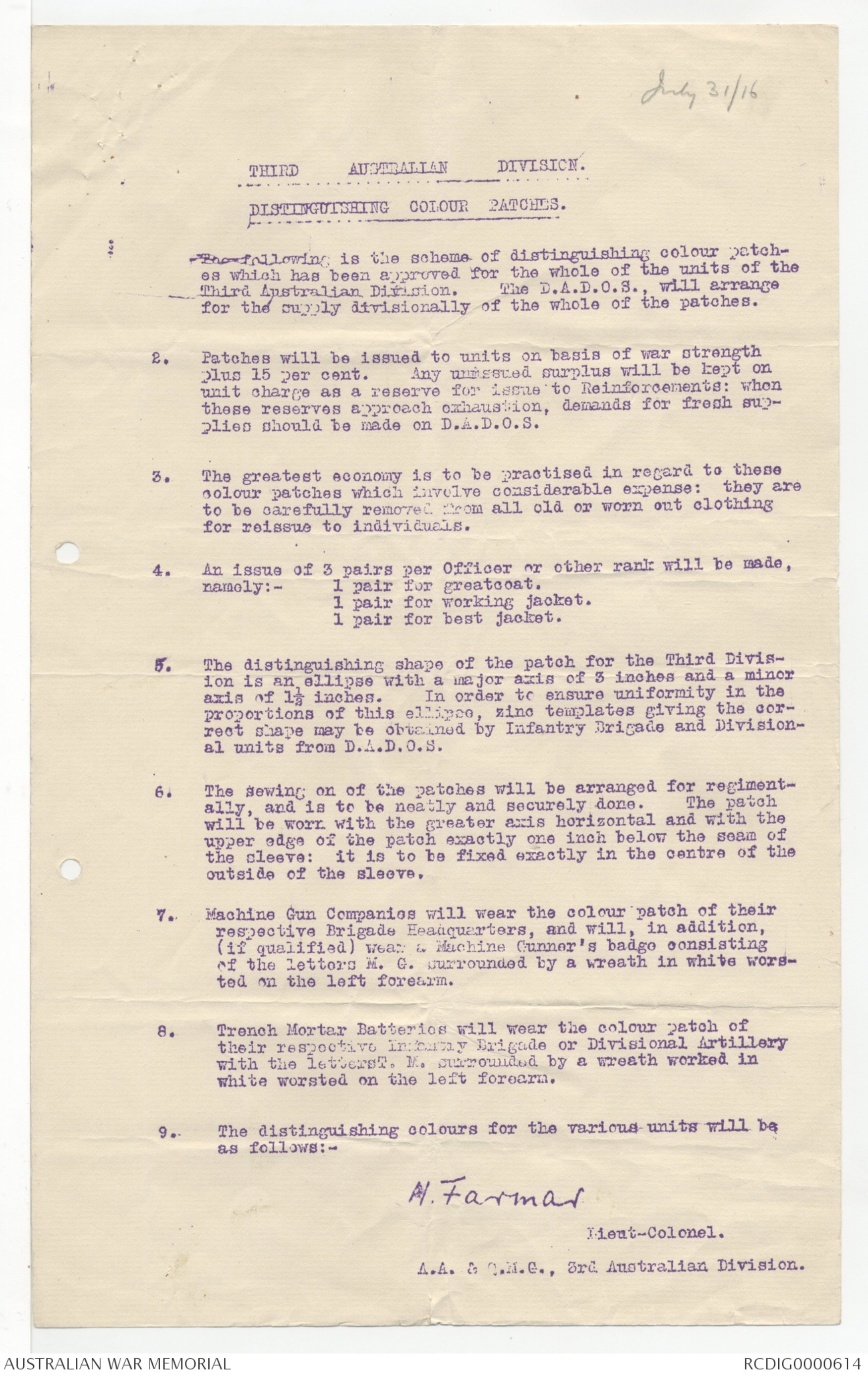
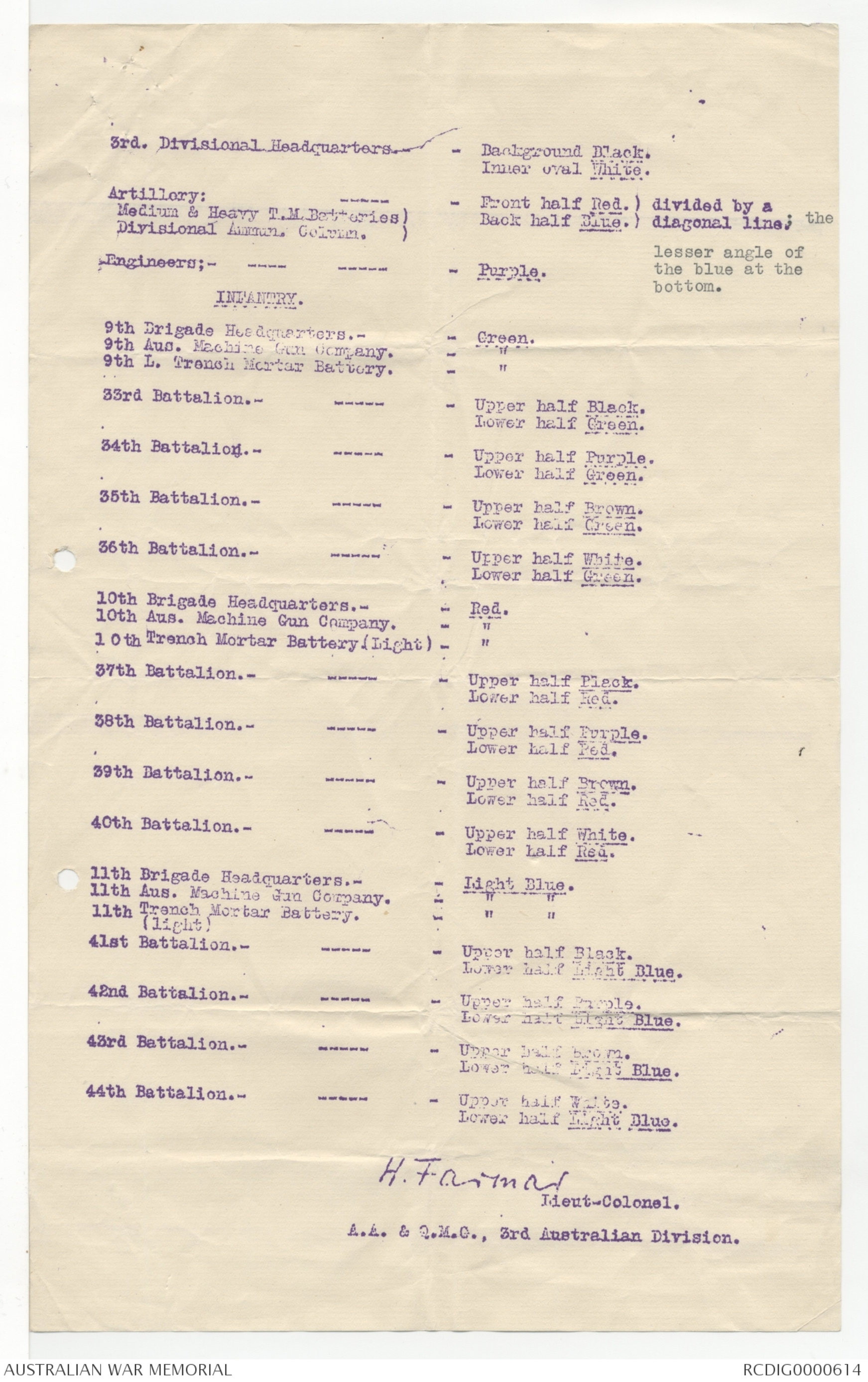
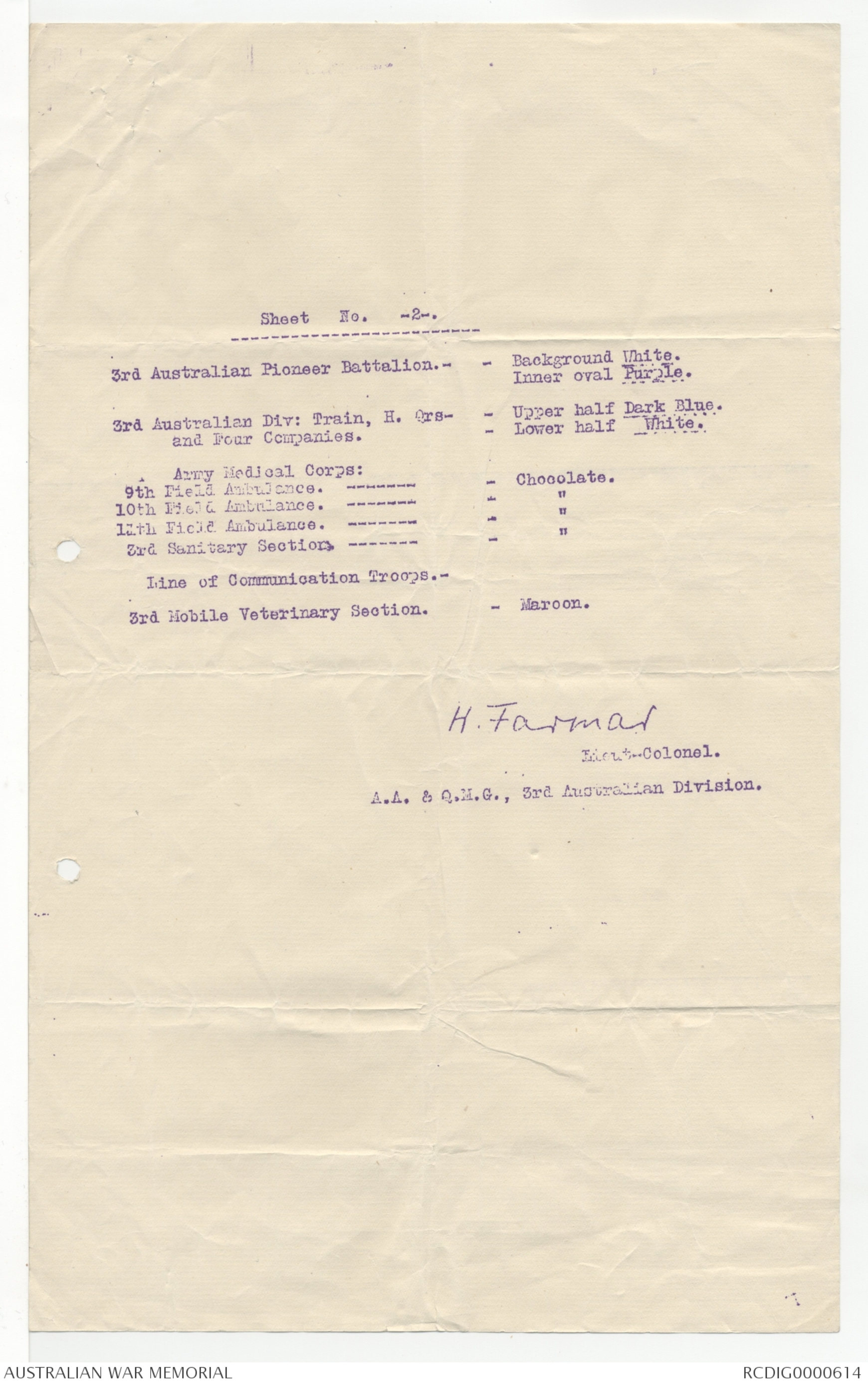
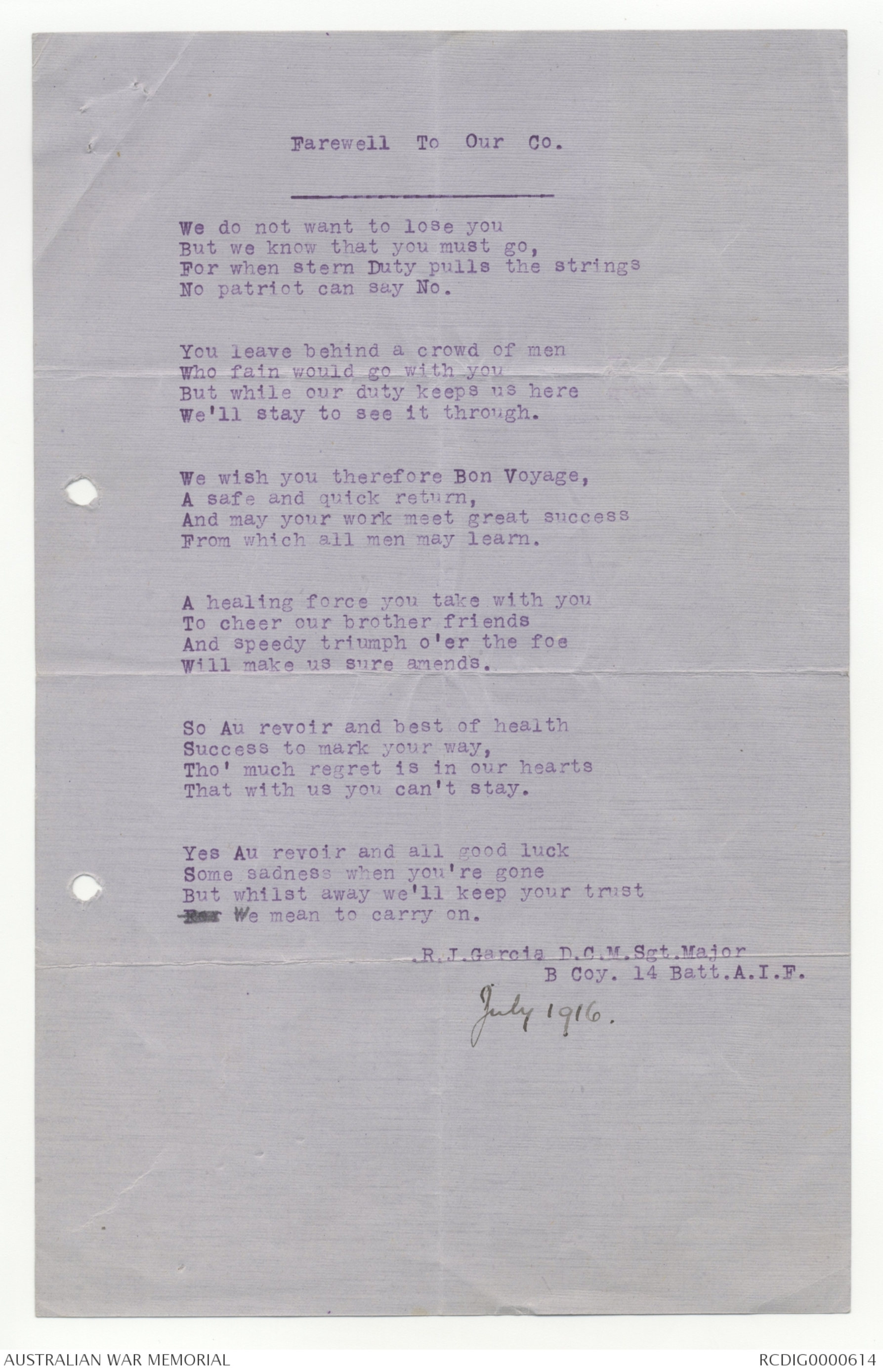
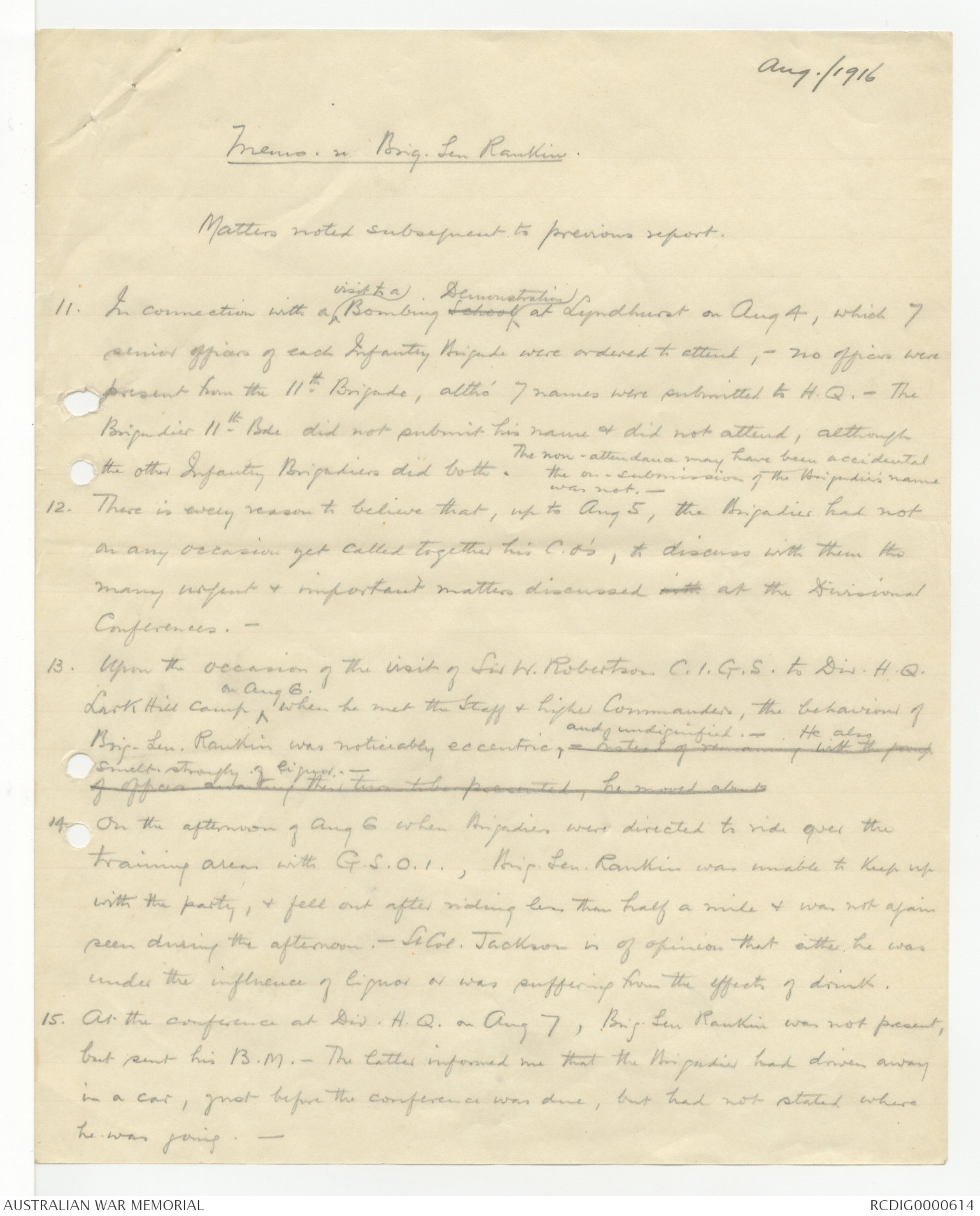
(3).
II. Re-organise and open fire after bayonetting
dummies on gallows and in trenches.
III. Handle and carry the bayonet in close formation.
IV. Charge magazines whilst advancing at the double.
V. Approach for the assault in suitable formations.
VI. Open rapid fire after assault Practices.
VII. Advance over broken ground, through woods, etc. at night.
7. Co-operation
of rifle fire.
Men must be made to realise the value of the co-operation
of rifle fire during and after a bayonet
assault. All magazines must be charged before making
an assault, not to fire during the melee, but to check
a counter attack after the position has been taken,
and when men are too exhausted after their exertions
for further bayonet work.
Squads must be constantly practised in reforming
after carrying out an assault and opening rapid fire.
This can be done during the 3rd. practices of lessons,
and assault practises.
8. Surmounting
Obstacles.
During assault practices, men are practised in
handling their rifles when jumping over, and in getting
in and out of trenches; they should also be trained
to vault and climb over obstacles while carrying a
rifle and bayonet in the hand. During this training
the scabbards should be put on the bayonets.
9. The Bayonet
in Defence.
The bayonet is essentially a weapon of offence -
all attacks should be met with the bullet. If a
counter attack with the bayonet has to be launched
against an attack, it should be withheld until the
enemy has straggled out and become exhausted, and
then hurled against it. The exhausted leaders of
the attack, the fittest and bravest of the enemy
should be killed without difficulty; those in the
rear, the less fit and more prudent, will become de-moralised
and commence to waver. If at this point a
counter attack with the bayonet is pushed with vigour,
this wavering will be converted into a rout; the
flying enemy must be followed up and bayonetted in
the kidneys. The rout will in all probability
further degenerate into a panic.
10. Meeting
Charge with
Counter
Charge.
Troops firing from front line trenches should not
be asked to meet charge with counter charge; it is
just what the enemy would like. The period taken by
us in getting out of our trenches would give him exactly
that respite from rapid rifle fire at the
final stage, which he would hope for.
If a charge is to be met by counter
charge, the latter must be carried out by troops
specially detailed from positions in rear of
the firing line.
It should be so timed as to reach our front line
trenches at the same moment that the head ^leading men of the
hostile charge get there. The men in the front line
would continue to pour in rapid rifle fire; thus the
enemy would be subjected to rifle fire up to the
last moment - then met by line upon line of fresh
men charging from support and assembly trenches.
11. Assault.
It is essential to keep men more or less in line
when advancing to the assault these must be in several lines.
One thin line has not the necessary drive or moral
effect; a mob charging becomes spread out, the best
men draw ahead and the troops assume a cone shaped
formation; this is eminently suitable for the
enemy to concentrate fire on - the head of the cone
is destroyed and the base withers away.
12. The following points should never be lost sight of -
1. A man will fight with more determination when he has a
definite and, if possible, tangible object to attain.
2. A man fights with confidence when he knows he will have xxx support from behind and protection on his flanks.
3. Supporting fire from behind has a stimulating as well as
a moral and material effect.
4. The vulnerable part of an attack is the flank. An attack
should never be made with flanks in the air.
5. An attack must be built up on a solid foundation.
6. Before making an attack, be sure that its supply,
communication, and protection are complete.
7. An attack against rapid fire must be made under some form
of cover, i.e. fire, surprise, darkness, fog, smoke, gas,
etc.
8. The directing force of an attack should be in front, and
the driving and controlling force from behind.
9. The less the range of a weapon, the further it must be
pushed forward.
10. The bayonet is essentially a weapon of offence.
11. The bayonet is useless in the hands of an exhausted man.
12. In an assault every man must be able to see the enemy, and
have sufficient room to use his bayonet.
13. A bullet kills quicker, travels further, and requires
less effort to use than a bayonet.
14. A counter attack is best checked with the bullet and bomb.
15. The bomb is apt to paralyse the offensive which is best
pushed forward with the bullet and bayonet.
16. A bomb acts both ways - the bullet and bayonet act only
one, viz., forward. They have no back lash, and so are
not likely to make men sticky.
17. An attack to succeed must be properly controlled.
18. The offensive should be made in a series of waves, each
wave being self-contained, and advancing from a solid
base, with flanks protected.
19. Each wave must be given a definite line to take and consolidate.
20. The best troops should be kept in reserve, and the next
best in support.
21. Calculate four men for every yard of front to be taken,i.e. - four men per yard per wave, though there are onlythree lines in a wave.
22. In order to facilitate control, each wave should have a
distinguishing badge, and the advance made above ground
and not through communication trenches.
23. Every open attack should be assisted by and protected
with supporting and covering fire from behind and both
flanks.
24. Officers should advance in front of an attacking line,
the N.C.O's in rear of it.
25. They should be far enough in front to be seen by their
own men, but so close as to appear to be in the line,
when looked at from the enemy's side.
26. Troops advancing to assault should not be doubled more
than 100 yards.
27. The final charge (made only if shock action is necessary
to defeat the enemy) should not exceed 20yds Immediately
the bayonet men have cleared the enemy's line, fire
positions must be prepared to resist the counter attack.
28. Attacking lines should be about 100 yards apart.-
assaulting line, supporting line, and consolidating line
forming one wave.
29. The second wave passes through the first and goes on to
its own objective, if the first has been successful. If
not, it completes the partial success of the first.
30. Officers must work out very carefully the formations in
which waves and the various lines of each wave will move;
must define the duties, and must lay down what each line
will carry in the way of tools, ammunition and equipment.
31. Bayonet Training, 1916 - Provisional. - will repay careful
study.
G. H. Jackson.
Lieut-Colonel,
General Staff.
THIRD AUSTRALIAN DIVISION.
DIVISIONAL HEADQUATERS,
LARKHILL, 31st, July, 1916.
GENERAL STAFF TRAINING CIRCULAR No. 6.
POINTS FOR PLATOON COMMANDERS.
1. The term "Platoon Commander" covers both Subalterns and
N.C.O's acting as such. For the purpose of this memo, the
seniors in charge of Machine Gun Detachments, Signallers,
and Transport are to be considered as Platoon Commanders.
2. Each Platoon Commander should be in possession of a Nominal
Roll of his Platoon, with the rank, number, and full name,
civil occupation, technical trade (if any). He should keep
notes of the men who are good rifle shots, who would make
good scouts, who are competent to act as Clerks, who are
handy with tools, or who possess any other qualifications
likely to be of military value. He should know all his men
by sight and by name.
3. The Platoon Commander is directly responsible for the
soldierly bearing and efficiency of his whole Platoon, and
of every man in it. By being assiduous in fostering the
mens' confidence in him as a leader, and in his concern for
their welfare, he can soon acquire such an influence over
the men as to ensure an all-round improvement in their
bearing and behaviour. Most men can be readily deterred
from wilful or careless disobedience or neglect, and from
intemperance, by quietly yet forcibly impressing them upon
them the folly of misbehaviour and of following a bad example.
4. The Platoon Commander must insist upon the
observance by every man of the essentials of soldierly efficiency. The
following are some of the matters which require his constant
vigilance, and for whose observance he will be held responsible.-
(a). Promulgation to the men of all orders, especially those
affecting their conduct.
(b). Personal cleanliness, regular shaving and haircutting,
bathing, washing of underclothing, repairs to underclothing,
boots and web equipment.
(c). Correct wearing of battalion colours, badges, etc.
(d). Improving the fit of clothing, particularly jackets about
the neck, where this can be effected by exchange, or by in-expensive
tailoring alteration - replacing lost buttons, removing
grease stains from clothing.
(e). Care of arms - condition of bayonets.
(f). Prevention of unauthorised markings on headdress and clothing.
(g). Punctilious saluting of all officers - a soldierly bearing
on all occasions.
(h). Inspection of men going on leave, and correction of defects
in appearance before men are permitted to do so.
(i). Suppression of the use of bad language.
(j). Perfect quiet in tents and lines between "lights out" and
"reveille".
(k). Eradication of the habit of throwing litter and rubbish
about camp lines instead of placing in proper receptacles.
(l). Punctuality.
(2).
(i). Suppression of the use of bad language.
(j). Perfect quiet in tents and lines between "lights out" and
"reveille".
(k). Eradication of the habit of throwing litter and rubbish
about camp lines instead of placing in proper receptacles.
(l). Punctuality.
(m). Correct bearing and position of limbs and body on parade -
correct soldierly gait.
(n). Smartness of movement and action in execution of all
orders.
5. The Platoon Commander must realise that it is his duty,
not merely to check and correct all defects, but to inculcate
in all men under his command the substitution
of good for bad habits,- i.e. to make the correct thing
habitual.
6. In carrying out these duties, the Platoon Commander
must be able to reply rely upon the active support and
assistance of his N.C.O.'s. His first business therefore
is to ensure such co-operation by insisting on the
N.C.O's setting an example to the men in all things.
If any N.C.O. fails in this duty, it is the business
of the Platoon Commander to endeavor, first to improve
the N.C.O. himself, and in default of improvement, to
secure his retirement in favor of a better man.
July 31/16
THIRD AUSTRALIAN DIVISION.
DISTINGUISHING COLOUR PATCHES.
The following is the scheme of distinguishing colour patches
which has been approved for the whole of the units of the
Third Australian Division. The D.A.D.O.S., will arrange
for the supply divisionally of the whole of the patches.
2. Patches will be issued to units on basis of war strength
plus 15 per cent. Any unissued surplus will be kept on
unit charge as a reserve for issue to Reinforcements: when
these reserves approach exhaustion, demands for fresh supplies
should be made on D.A.D.O.S.
3. The greatest economy is to be practised in regard to these
colour patches which involve considerable expense: they are
to be carefully removed from all old or worn out clothing
for reissue to individuals.
4. An issue of 3 pairs per Officer or other rank will be made,
namely:-
1 pair for greatcoat.
1 pair for working jacket.
1 pair for best jacket.
5. The distinguishing shape of the patch for the Third Division
is an ellipse with a major axis of 3 inches and a minor
axis of 1½ inches. In order to ensure uniformity in the
proportions of this ellipse, zinc templates giving the correct
shape may be obtained by Infantry Brigade and Divisional
units from D.A.D.O.S.
6. The sewing on of the patches will be arranged for regimentally,
and is to be neatly and securely done. The patch
will be worn with the greater axis horizontal and with the
upper edge of the patch exactly one inch below the seam of
the sleeve: it is to be fixed exactly in the centre of the
outside of the sleeve.
7. Machine Gun Companies will wear the colour patch of their
respective Brigade Headquarters, and will, in addition,
(if qualified) wear a Machine Gunner's badge consisting
of the letters M.G. surrounded by a wreath in white worsted
on the left forearm.
8. Trench Mortar Batteries will wear the colour patch of
their respective Infantry Brigade or Divisional Artillery
with the letters T. M. surrounded by a wreath worked in
white worsted on the left forearm.
9. The distinguishing colours for the various units will be
as follows:-
H. Farmar
Lieut-Colonel.
A.A. & Q.M.G., 3rd Australian Division.
| 3rd. Divisional Headquarters. - |
- |
Background Black. Inner oval White. |
| Artillory: ----- Medium & Heavy T.M. Batteries) Divisional Ammn. Column. |
- |
Front half Red.) divided by a Back half Blue.) diagonal line; the lesser angle of the blue at the bottom. |
| Engineers;- ---- ---- |
- |
Purple. |
| INFANTRY. |
|
|
| 9th Brigade Headquarters.- 9th Aus. Machine Gun Company. 9th L. Trench Mortar Battery. |
- |
Green. " " |
| 33rd Battalion.- ----- |
- |
Upper half Black. Lower half Green. |
| 34th Battalion.- ----- |
- |
Upper half Purple. Lower half Green. |
| 35th Battalion.- ----- |
- |
Upper half Brown. Lower half Green. |
| 36th Battalion.- ----- |
- |
Upper half White. Lower half Green. |
| 10th Brigade Headquarters.- 10th Aus. Machine Gun Company. 10th Trench Mortar Battery. (Light) |
- |
Red. " " |
| 37th Battalion.- ----- | Upper half Black. Lower half Red. |
|
| 38th Battalion.- ----- | Upper half Purple. Lower half Red. |
|
| 39th Battalion.- ----- | Upper half Brown. Lower half Red. |
|
| 40th Battalion.- ----- | Upper half White. Lower half Red. |
|
| 11th Brigade Headquarters.- 11th Aus. Machine Gun Company. 11th Trench Mortar Battery. (light) |
Light Blue. " " " " |
|
| 41st Battalion.- ----- | Upper half Black. Lower half Light Blue. |
|
| 42nd Battalion.- ----- | Upper half Purple. Lower half Light Blue. |
|
| 43rd Battalion.- ----- | Upper half Brown. Lower half Light Blue. |
|
| 44th Battalion.- ----- | Upper half White. Lower half Light Blue. |
H Farmar
Lieut-Colonel.
A.A. & Q.M.G., 3rd Australian Division.
Sheet No. -2-.
| 3rd Australian Pioneer Battalion.- |
- |
Background White. Inner oval Purple. |
| 3rd Australian Div: Train, H. Qrs- and Four Companies. |
- |
Upper half Dark Blue. Lower half White. |
| Army Medical Corps: 9th Field Ambulance. ------- 10th Field Ambulance. ------ 13th Field Ambulance. ------ 3rd Sanitary Section. -------- |
- |
Chocolate. " |
| Line of Communication Troops.- |
|
|
| 3rd Mobile Veterinary Section. |
- |
Maroon. |
H Farmar
Lieut-Colonel.
A. & Q.M.G., 3rd Australian Division.
Farewell To Our Co.
We do not want to lose you
But we know that you must go,
For when stern Duty pulls the strings
No patriot can say No.
You leave behind a crowd of men
Who fain would go with you
But while our duty keeps us here
We'll stay to see it through.
We wish you therefore Bon Voyage,
A safe and quick return,
And may your work meet great success
From which all men may learn.
A healing force you take with you
To cheer our brother friends
And speedy triumph o'er the foe
Will make us sure amends.
So Au revoir and best of health
Success to mark your way,
Tho' much regret is in our hearts
That with us you can't stay.
Yes Au revoir and all good luck
Some sadness when you're gone
But whilst away we'll keep your trustxxx We mean to carry on.
.R. J. Garcia D.C.M. Sgt. Major
B Coy. 14 Batt. A.I.F.
July 1916.
Aug./1916
Memo. on Brig. Gen Rankin
Matters noted subsequent to previous report.
11. In connection with a ^visit to a Bombing School^ Demonstration at Lyndhurst on Aug 4, which 7
senior officers of each Infantry Brigade were ordered to attend,- no officers were
present from the 11th Brigade, altho' 7 names were submitted to H.Q. - The
Brigadier 11th Bde did not submit his name & did not attend, although
the other Infantry Brigadiers did both. The non-attendance may have been accidental
the on - submission of the Brigadier's name was not.-
12. There is every reason to believe that, up to Aug 5, the Brigadier had not
on any occasion yet called together his C.O's, to discuss with them the
many urgent & important matters discussed with at the Divisional
Conferences.-
13. Upon the occasion of the visit of Sir W. Robertson C.I.G.S. to Div. H.Q.
Lark Hill Camp ^on Aug 6. when he met the staff & higher Commanders, the behaviour of
Brig-Gen. Rankin was noticeably eccentric, and undignified. - He also
smelt strongly of liquor.- instead of remaining with the groupof officers awaiting their turn to be presented, he moved about
14. On the afternoon of Aug 6 when Brigadiers were directed to ride over the
training areas with G.S.O.I., Brig. Gen. Rankin was unable to keep up
with the party, & fell out after riding less than half a mile & was not again
seen during the afternoon. - Sr Col. Jackson is of opinion that either he was
under the influence of liquor or was suffering from the effects of drink.
15. As the conference at Div. H.Q. on Aug 7, Brig Gen Rankin was not present,
but sent his B.M. - The latter informed me that the Brigadier had driven away
in a car, just before the conference was due, but had not stated where
he was going. —
 Deb Parkinson
Deb ParkinsonThis transcription item is now locked to you for editing. To release the lock either Save your changes or Cancel.
This lock will be automatically released after 60 minutes of inactivity.